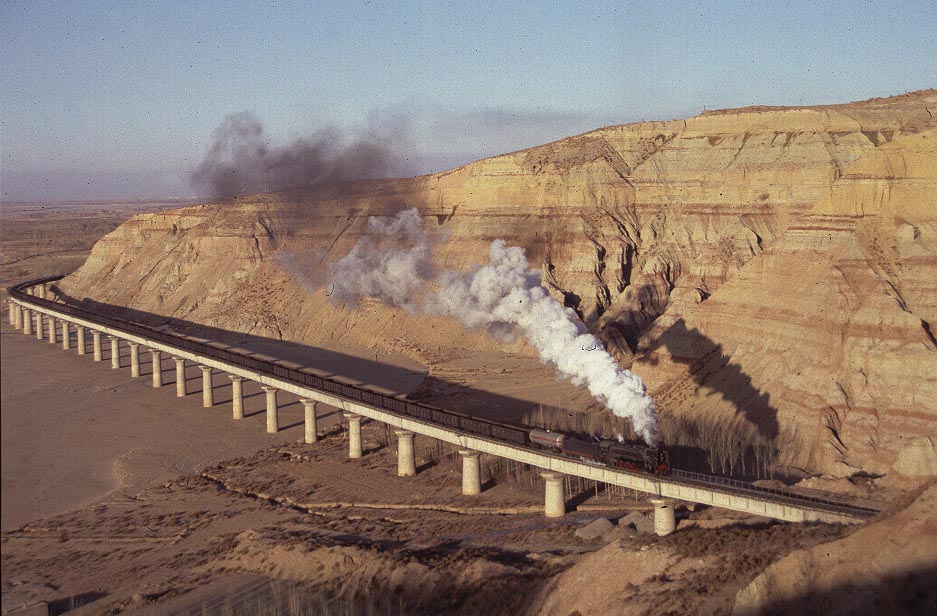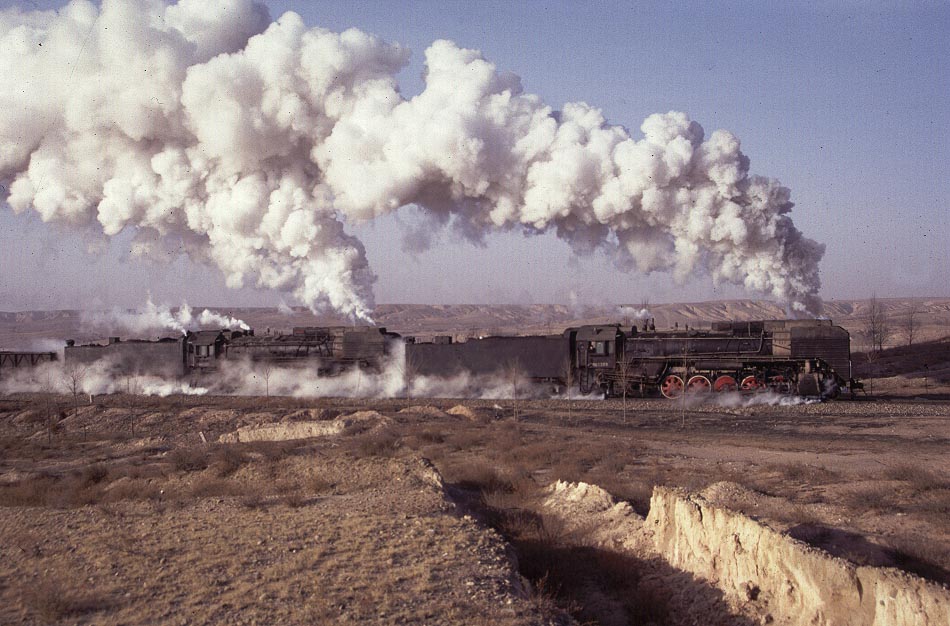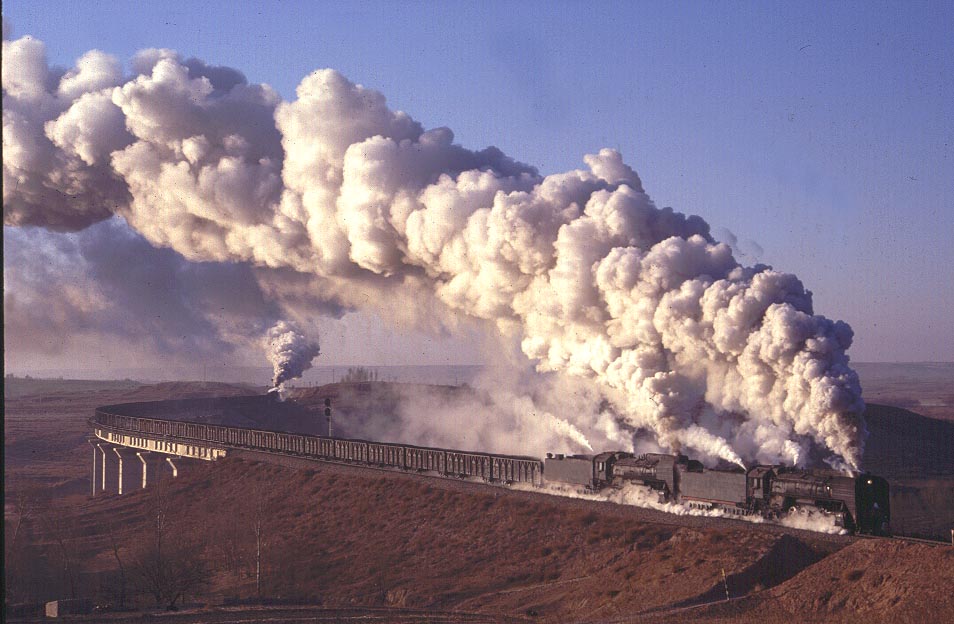| BAOTOU As a friend of mine recently remarked, running a web site about steam in China is akin to writing an obituary column. Each week seems to bring news of yet another steam line giving up to the onslaught of the diesels and if I were to remove pages from this site as this happened then pretty soon there would be nothing left at all. Also a vital piece of historical record would be lost and for that reason alone it remains my intention to at least keep the exisitng pages for those who are interested in 'the way things were'. The page on the Batou/Dongsheng/Aobaogou area is a particualr favourite of mine as it records my first experiences with mainline Chinese steam. Baotou is about 600km to the west of Beijing. When I visited this area in 1998 there was a great deal of steam activity to be seen. In addition to the steelworks (which still operates steam in 2007) there were steam hauled suburban trains every morning and evening, although unfortunately in December these only operated during the hours of darkness. There was also a branch line to the collery at Shiguai..... but by far the most interesting line is the one which still runs southward from Baotou to Dongsheng and then on to the coal mines at Shenmu. The section from Baotou Dong to Dongsheng was mainly operated by single QJ's but the section to the south of Dongsheng regularly saw trains containing over 3000 tons of coal. These required double-headed QJ's and in the area around Aobaogou, which is just to the south of Dongsheng, these trains required further assistance from a QJ acting as a banking engine. The sight and sound of these trains as they climbed the last few miles was simply breath-taking and must have been some of the best steam action in the world at that time. It is impossible to convey in words the impact that these mighty trains had on a visitor to the area. The sheer scale was incredible and the frequency of trains was also surprising. The cold weather and subsequent steam effects gave added dramatic impact and certainly the photograph of the two locomotives comming off the viaduct near Aobaogou remains one of the best I have ever had the pleasure to take. Although only one shot is illustrated below it forms part of almost a cine film sequence of shots - so magnificent was the sight that I couldn't keep my finger off the shutter button! |
| Baotou was really my introduction to steam in China on my first visit in 1998. We had already spent an afternoon at the Dahuichang Limestone works in Beijing and a day at Singing Sands (when very little traffic had been evident) but it was Donsheng and Aobaogou where it really all kicked off. We had only just arrived when the first coal train came into view in the pre-dawn light and my world has never really been the same since! The incredible noise and power, firstly from the leading pair of engines and then from the banker, took my breath away. Suddenly those endless hours on the plane and then the long journey by road seemed incredibly worthwhile! |
| Click on locations below for more Chinese steam (systems shown in yellow now no longer have steam) ANSHAN STEELWORKS BEITAI STEELWORKS BENXI STEELWORKS CHENGDE HANDAN STEELWORKS FUXIN NANPIAO MEIHEKOU JIXI JINGPENG TIEFA WEIHE XUANHAU STEELWORKS YUANBAOSHAN |
 |
| By the late 1990's there were very few places where steam was still operated on China National Railways. However around Baotou there was still a suburban steam service which operated in early morning and late afternoon. This made photography almost impossible in December but at first light QJ6248 can just be seen crossing the thickly frozen Yellow River with a passenger train 31 December 1998 |
 |
| Between Baotou and Dongsheng the railway runs along an enormous concrete viaduct at a point known as Singing Sands. This is right on the edges of the Gobi desert and indeed the wind appears to make the sand 'sing'. Sand ski-ing here is also popular - complete with chair lifts! The viaduct carries the railway along the bed of the river - which although dry in winter can become a raging torrent in the wet season. We waited here the best part of a day for the shot - but in the end patience was rewarded. |
 |
| Having spent the night in Dongsheng we were up before dawn to get to Aobaogou which is to the south of Dongsheng. As dawn broke we could hear the approach of a coal train coming from the direction of Shenmu. As it got closer the scale was staggering - as was the noise made by the QJ2617 and 6711 at the front of the train and QJ6248 banking from the rear. Nothing had really prepared me for a sight like this and my breath was completely taken away. |
 |
| QJs 1892 and 1611 cross the curved viaduct to the south of Aogaogou station with a long train of empty wagons heading for the mines at Shenmu. In the left hand background can be seen the chimney of Dongsheng power station - one of the users of the coal brought from the mines. |
| And the trains keep on coming ........ a picture which gives a real idea as to the length of the coal trains which operated on this line. It was often difficult to find a location where the three engines could all be included in a single picture. On this occasion QJs6289 and 2586 are in the lead with QJ3068 bringing up the rear - all three engines working hard against the gradient. |
 |
 |
| A side-on view of the same train gives a good idea of the amount of work the engines were doing and also shows off well the lines of the QJ class 2-10-2 locomotives. At the time it seemed that the QJ would become the only working engines in China but in fact they have been largely outlived by the JS and SY classes of locomotives which can still be found at a number of locations. However nowhere do they handle work of this magnitude. |
 |
| With its blow down valve fully on QJ1269 makes a magnificent sight as it accelerates away from Aobaogou with the morning passenger train. The traditional green and cream coaches lend terrific attraction to this scene. |
 |
| The local track gang take refuge as yet another monster coal train heads towards Dongsheng. This shot shows the banker, QJ6248, hard at work providing assistance to the two train engines. |
 |
| Our first afternoon was spent to the north of Aobaogou where the railway crosses yet another massive concrete viaduct over a river. The weather however deteriorated but not before we were able to see QJ3068 returning light engine on banking duty. |
 |
| Next morning saw a flying visit to Dongsheng engine depot before heading out to the lineside for another days photography. Like most depots the prepation work and indeed the stabling of the locomotives takes place outside despite the freezing temperatures |
 |
| The first rays of the new morning sun catch the paintwork and exhaust of QJ3068 as its made ready for another day of hard work as a banking engine. |
 |
| On this, my first visit to China, I had joined with five other British enthusiasts and we had engaged the services of Li Weshui who had a reputation for being not only a first-rate guide but unusually also as a first rate railway photographer. Li knew his raileway lines well and could always be relied upon to give good advice and guidance. On the second morning most of the group were determined to reach a viaduct about a mile and a half from Aobaogou station. Li was sceptical baout their ability to reach the viaduct in time and advised that they should wait nearer to Aobaogou. However they were determined and set off leaving just Li and myself stood on the hillside overlooking the curved viaduct. It wasn't long before we heard a train approaching and we knew the others could not have reached their destination in time. All that we could do was to make the most of a fantastic opportunity as the train came into sight in the early morning light on an almost still day - the smoke hanging almost motionless in the air. It was simply one of the most breathtaking sights it has ever been my pleasure to witness and record. |
 |
 |
| Since the line was only a single track, trains had to wait in passing loops before heading on their journey. While we had been photographing the northbound train, QJ1891 had been sitting patiently in the loops at Aogaobou station. |
 |
| With the road ahead now clear QJ1891 gets its long train of empties on the move after the enforced wait at Aogaobou. Since the line is downhill and the wagons are empty a single QJ is quite sufficient - the use of double-headed QJs on trains of empties was simply a way of returning enough engines to Shenmu to bring back loaded wagons. |
 |
| After the previous days poor weather we were determined to have a second attmpt to catch a train crossing the long viaduct to the north of Aobaogou station. Whilst waiting for the next coal train we were able to watch the passing of the morning passenger train - this time in the hands of QJ6289. |
 |
| Our patience was finally rewarded! The train almost fitted onto the complete length of the viaduct and we were able to enjoy QJ6017 and 1611 heading towards us in the late morning sunshine with QJ3068 away off in the distance bringing up the rear of this incredible train. |
 |
| With Dongsheng just around the corner the two leading locomotives make the final effort to bring their train up from the mines. No doubt the crews were looking forward to a well deserved rest on arrival! |
 |
| A chance for one last photograph at Aobaogou as QJ's 6018 and 6247 speed southwards on a balanced working, |
 |
| Our next destination was Benhong and a chance to catch the overnight steam hauled sleeper train to Jing Peng. To get there we had to retrace our steps and were lucky enough to catch QJ2586 on a train of empty coal wagons about to enter Singing Sands Gorge. |